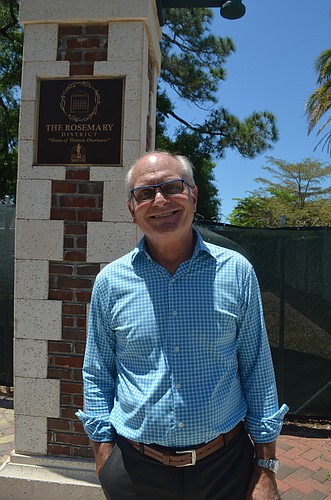- December 18, 2025
-
-
Loading

Loading

A group of property owners, merchants and residents are trying to stake out a clearly defined identity for the Rosemary District. Before their work even began, though, people in Sarasota already had some common thoughts about the neighborhood’s identity.
It’s urban, edgy, authentic. City leaders have discussed the district’s potential, but right now, people see Rosemary as a segment of downtown with its own character worth preserving.
As more than 1,100 new residential units are added to the Rosemary District during the next three years, developer and property owner Howard Davis is working with other neighborhood stakeholders to proactively address a difficult question: How do you enhance the area’s positive attributes and avoid letting the character of the neighborhood get diluted after the deluge of construction?
On Tuesday, Davis led a presentation at City Hall regarding the future of the Rosemary District. Davis is part of a grassroots planning effort for the district, an effort to assess the community’s needs and desires before the neighborhood is built out.
At the meeting, Davis and Kimley-Horn planner Shawn Dressler shared the results of a survey about the district. During the past two months, more than 200 people answered a series of questions about the area’s strengths and weaknesses, as well as their vision for Rosemary.
The goal, Davis said, is to create a community-driven list of principles for improving the district. The group isn’t getting any city money for the planning effort, but Davis said those who have invested in the Rosemary District want the neighborhood to reflect the desires of the public.
“Early on, we said we’re going to listen as closely as possible to the community in as many different ways as possible,” Davis said. “That’s what we’ll use as we put the plans together.”
Davis said the results aren’t necessarily surprising, but they do provide concrete data regarding the neighborhood’s public perception. There are several common themes: People like that the neighborhood is walkable and in close proximity to downtown and the bayfront. They don’t like that it feels unsafe and lacks park space.
The survey also revealed some words people associate with their long-term vision for the neighborhood. They want it to be exciting, vibrant, creative — many of the same characteristics people already attach to the district.
For Michael Bush, president of the Rosemary District Neighborhood Association, the knowledge that most people are saying similar things is a good sign.
“I think what you saw there is tremendous consensus,” Bush said. “When you’re working with consensus, I think getting to those defining points will be easier.”
The grassroots planning initiative turned the survey results into a vision statement and series of guiding principles for the neighborhood. Those planning guidelines are still in draft form, but they reflect the key findings residents have shared. They want more connectivity. They want to embrace the district’s past, and they want to support the businesses that are already there.
Some of the findings invite bigger questions. The survey indicates there is a large gap in the neighborhood’s retail offerings. More than 50% of respondents said they wanted to see more shops, restaurants, grocery stores and entertainment venues in the neighborhood.
It’s one thing to know those types of businesses are missing from the neighborhood. It’s another to actually get them woven into the fabric of the district. But the group’s work isn’t done — after refining the guiding principles with other stakeholders, Davis hopes to produce a series of recommendations for how the Rosemary District can take action to address its most pressing needs.
The group hopes to share those recommendations in June — at which point more unanswered questions will arise, including how any improvements will get funded. Davis doesn’t want to get bogged down with details like that right now, and his sense is that the rest of the community doesn’t, either.
Beyond the specifics of the answers to the survey, Davis was struck by how positive the tenor of the feedback was. He’s done similar planning efforts in other communities, and he said that’s not always the case. He said the positive energy will keep the planning effort moving forward, aggressively addressing the obstacles in its way as residents seek a better future for the Rosemary District.
“Most people want to talk to you about problems,” Davis said. “And there were a few — but there was much more emphasis on a positive future.”